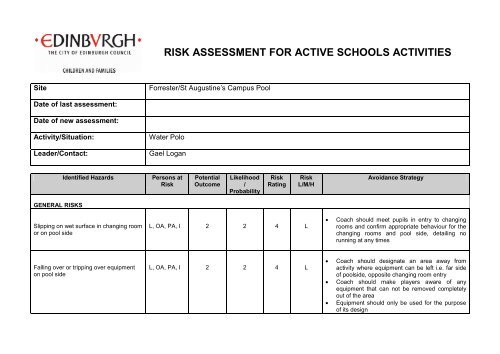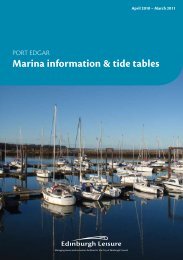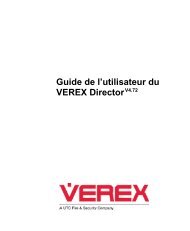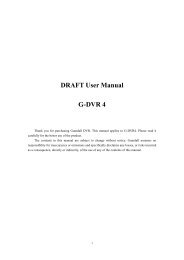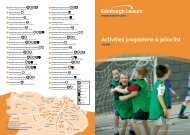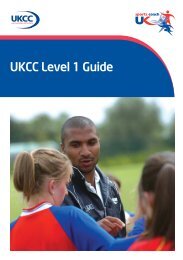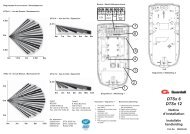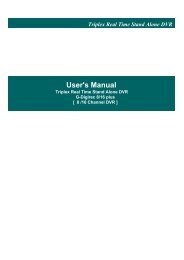risk assessment for active schools activities - Ch-change.com
risk assessment for active schools activities - Ch-change.com
risk assessment for active schools activities - Ch-change.com
Create successful ePaper yourself
Turn your PDF publications into a flip-book with our unique Google optimized e-Paper software.
RISK ASSESSMENT FOR ACTIVE SCHOOLS ACTIVITIESSiteForrester/St Augustine’s Campus PoolDate of last <strong>assessment</strong>:Date of new <strong>assessment</strong>:Activity/Situation:Water PoloLeader/Contact:Gael LoganIdentified HazardsPersons atRiskPotentialOut<strong>com</strong>eLikelihood/ProbabilityRiskRatingRiskL/M/HAvoidance StrategyGENERAL RISKSSlipping on wet surface in changing roomor on pool sideL, OA, PA, I 2 2 4 L• Coach should meet pupils in entry to changingrooms and confirm appropriate behaviour <strong>for</strong> thechanging rooms and pool side, detailing norunning at any timesFalling over or tripping over equipmenton pool sideL, OA, PA, I 2 2 4 L• Coach should designate an area away fromactivity where equipment can be left i.e. far sideof poolside, opposite changing room entry• Coach should make players aware of anyequipment that can not be removed <strong>com</strong>pletelyout of the area• Equipment should only be used <strong>for</strong> the purposeof its design
RISK ASSESSMENT- Dance WorkshopsEdinburgh Youth Games 2011Venue: Jack Kane Centre Times: 10:45-2pm Date: Thurs 12 th May2011Leader: Cat PerryAreas being used: Jack Kane Centre- ½ of MainStaff: Anna Michaelides, HallGemma Duncan and Emma<strong>Ch</strong>ristieActivity: DanceWorkshopsNew AssessmentDate:First Aid AppointedPerson: Cat Perry andAnna MichaelidesIdentified HazardsPersons at<strong>risk</strong>PotentialOut<strong>com</strong>eLikelihood/ProbabilityRiskRatingRiskL/M/HAvoidance StrategySlips, trips andfallsParticipantsand staff3 2 5 L Rules and conduct will be clearly explained tothe per<strong>for</strong>mers.Staff will be vigilant and positionedthroughout the area, making sure the sessionsare safe and participants are not at <strong>risk</strong> ofcausing injury to themselves or others. Therewill be staff positioned in all areas. Allequipment will be stored at the sides on thespace and participants will be made aware ofthis.
Number ofparticipantsParticipantsand Staff335LThe hall will be of appropriate size toac<strong>com</strong>modate the volume of participants.There will be 4 instructors position amongstthe participants providing guidance andindividual help and assistant when needed.Participants will be made aware of space andspecial awareness and encouraged to havesufficient space throughout the workshops.Clothing and shoesParticipants222LParticipants will be given advice andinstructions on appropriate clothing andfootwear <strong>for</strong> the dance workshops.<strong>Ch</strong>eerleadingStunts and lifts438MMats will be put out when stunting and lifts.The group will be spit up into four smallergroups (approx 20 each group) lead by aninstructor each.<strong>Ch</strong>eerleading stunts and lifts will be fullyexplained and taught through by leadinstructor and watched and help by instructorat each group.Safety will be explained and each group mustshown understanding of the safety elementsand what they role is in the stunt be<strong>for</strong>e thestunt will be attempted. Variations and less<strong>risk</strong>y stunts will always be tried first.Medical Participants, 3 2 5 L Appointed First Aiders who will deal with
Emergencies and staff any medical emergencies. Staff will askschool staff and representatives if there areany medical issues they need to be madeaware of be<strong>for</strong>e the sessions start and theappropriate participant is pointed out to staff.All participants are to have and appropriateand required medication <strong>for</strong> a practical dancesessionEvacuation- fireetcParticipantsand staff5 3 8 M The fire exits will be pointed out by the mainleader in all the areas be<strong>for</strong>e the sessions startand the evacuation procedure will beexplained. Make sure all staff are sure of thefire exits and evacuation procedures.Identified HazardsStagingPersons at<strong>risk</strong>Participantsand StaffPotentialOut<strong>com</strong>eLikelihood/ProbabilityRiskRating3 3 5 LRiskL/M/HAvoidance StrategyThe instructor leading the workshop will beteaching from a raised staging area.Participants are made aware and kept a safedistance away from the stage. Only the staffwill be allowed on the raised area and staffwill be made aware of any hazards. Staffwill be given a chance to practice and makethemselves familiar with the staging areasizeand feeling – be<strong>for</strong>e the event starts.
Assessment prepared by: Cat PerryDate: 12/4/11Potential Out<strong>com</strong>eNumerical ValueMinor Injury 1Injury needing medical attention 2Injury- off work/school 3Serious injury/long term sickness 4Fatality 5Likelihood/ ProbabilityNumerical ValueUnlikely 1Low possibility 2Possible 3Probable 4Near Certainty 5Risk RatingL/M/H1-5 Low6-12 Medium12+ High
Identified HazardsPersons atRiskPotentialOut<strong>com</strong>eLikelihood/ProbabilityRiskRatingRiskL/M/HAvoidance StrategySinking due to inappropriate swim wearor clothingPA 2 1 2 L • Coach should ensure appropriate clothing isworn at all times• Heavy or absorbent clothing will not be allowedDrowning L, OA, PA, I 5 1 5 L • Event organisers should ensure that nonswimmersare not included in the event• Coach should ensure that weak swimmersremain in the shallow end and within their depth• Coach should confirm evacuation procedure inthe event of a drowningMuscle strain or tear PA 2 1 2 L • Coach should ensure appropriate warm up timeon pool side and in the pool be<strong>for</strong>e each match• Coach should ensure appropriate cool down timein pool after each matchDehydration / Heat Exhaustion PA, I and L 2 1 2 L • Event organisers will ensure players have awater bottle available at all times• Coach should facilitate sufficient water and snackbreaks during the eventExhaustion PA 2 2 4 L • Coach should ensure subs are rolled, enablingsufficient rest during matches• Coach should ensure teams have sufficient restbetween matches• Players or lower ability should be encouraged toremain in shallower water• Players who are suffering from tiredness or at<strong>risk</strong> of exhaustion will be advised to sit out amatch
Risk <strong>assessment</strong> <strong>for</strong> Teambuilding Games at the BAA Youth Games2011Venue – Meadowbank Sports CentreRisk involved – use of a variety of equipment by a team of individualsspecifically designed to challenge group dynamics.Possible minor <strong>risk</strong>s - lifting and carrying.Hazards arising from <strong>risk</strong> – tripping, slipping, dropping and fallingEffects of hazard – cuts, bruises, sprains and in severe case brokenbonesRisk management – each team challenge game to have a writteninstruction sheet where applicable, a qualified / experienced leader to beon hand to explain and guide the team through the challenge and to stepin if and when he or she feels there is <strong>risk</strong> of injury to individuals or theteam.
AREA/TASK Risk Assessment:This section includes:BAA YOUTH GAMESGYMNASTICSMEADOWBANK SPORTS CENTRE- HALL 2• Coaches and Participants• Gymnastics Equipment• Playing/Coaching Area• Set and Breakdown of Equipment/StorageActivity: GymnasticsPersons at <strong>risk</strong>: Coaches & ParticipantsHow might they be harmed: muscular skeletal injuries through improper planning,supervision, class managementSeverity Rating (SR) 2/3/4Arrangements to examine/Questions Control measures in placeCoach:Are all coached <strong>activities</strong> supervised by Yesa qualified coach or teacher?Is the coach’s membership of their Yesqualifying body current?Do you have documentary evidence ofboth?Is the level of coaching award heldappropriate to the level being coached?Are they CRB checked?YesDoes the centre allow outside clubs tohire the facility and if so are coachesqualified, insured and CRB checked? YesIs there access to a first aid qualifiedperson and first aid kit?Yes, on siteParticipant:Are class sizes, ability and age groupscontrolled and teaching ratios set andadhered to?Are participants asked about medicalconditions / medication?Are they advised of suitable sportswear?Is boisterous/ disruptive behaviourcontrolled?No, however <strong>schools</strong> should have appropriatedocumentationYes, this has been monitored and a maximumamount per coach.Yes, this will be held on <strong>schools</strong> documentationThe school should do this be<strong>for</strong>ehandYes.Likelihood Rating __2___Risk Rating_3___
Activity: Gymnastics EquipmentPersons at <strong>risk</strong>: Coaches, participantsHow might they be harmed: injury through failure of equipment in use and transmissionof infection?Severity Rating (SR) 2/3Arrangements to examine/Questions Control measures in placeAre all items of gymnastics equipment Yes, all equipment is purchased throughmanufactured to CE/BSI Standards? approved suppliers.Are all items of equipment subject to an All equipment is checked by staff while it is beingappropriate level of inspection (preuse,visual monthly checks or <strong>for</strong>mal condition throughout the activity and report anyput out. The <strong>com</strong>petition manager will monitor theindependent annual inspections)? issues. Anything noted while putting theequipment out or away will be noted by coachesand staff. The equipment is weekly and majorIf any music equipment is used, is itsubject to an electrical pre-use visualinspection and <strong>for</strong>mal inspection / test?Are items of pre-school and gym tots’equipment subject to a cleaningregime?Are items of equipment likely to be“mouthed” by toddlers subject to acleaning regime / disinfecting?If soft play equipment is used, is itclean, in good repair and regularlyinspected?If a ball pond is used, is there anadequate depth of balls (450mm <strong>for</strong>juniors and 350mm <strong>for</strong> toddlers)?Are balls removed and cleaned /disinfected on a regular basis (as per<strong>risk</strong> <strong>assessment</strong> or at least every twomonths)?Is the ball pit inspected prior to eachsession?pieces receive annual certified checks.Yes, all equipment is supplied by the centre; anyfaults detected are reported by staff tomanagement and also by coaches during usage.All equipment is PAT tested annually.N/AN/AN/AN/ALikelihood Rating _2____Risk Rating __3___
Activity: Playing / Coaching AreaPersons at <strong>risk</strong>: Coaches, Leisure Attendants, Duty Managers, other staff othermembers of the public using the areaHow might they be harmed: slips, trips, cuts, abrasions, infection, and impact injuries?Severity Rating (SR) 2/3/4Arrangements to examine/Questions Control measures in placeArea :Main HallIs the wooden floor in a suitablecondition free from splinters and gapsin the boards at the entrance to anystorage area?Is there a suitable maintenanceprogramme?The floor is inspected and cleaned and checkedregularly throughout the week.The equipment is inspected by a representativefrom the Gymnastics club and subject to annualMaintenance Inspections by DW Play works.Are any wall bars, climbing ropes,suspended beams subject to a <strong>for</strong>malinspection regime by an independentbody?Are fire exit doors unobstructed andoperate freely?Are escape routes free fromobstruction?Are there sufficient emergency exitsfrom the area and are these accessible(if this is an after school activity checkdoors are unlocked prior to thesession).Can the coach / helper overseechildren at all times to include thechanging area and toilet trips?N/AThere are daily and weekly checks of the FireExits, these are recorded and any issues areactioned immediately through on site staffaddressing issues and anything more majorbeing reported to Maintenance.Yes and clearly sign posted.Yes, exits will be pointed out to all participants.The age groups are such that if the children areable to visit the toilets themselves. Each <strong>schools</strong>teacher/coach will manage this.Likelihood Rating __1___Risk Rating__3___
RECOMMENDATIONS FOR RISK REDUCTIONN/AAction By When? By Whom? CompletedSigned: Karen McGrath Date: 11 th April 2011Position: Gymnastics Development OfficerReview Date: N/A
Risk AssessmentThis Risk Assessment must beread in conjunction with all theGeneric Risk Assessments. Youshould also read the followingActivity Specific RiskAssessments where appropriate-IdentifiedHazardsFall off bikeImmobilisingincident / injuryLikelihood andSeriousness ofInjuryActivity SpecificMountain BikingProbable/Injury – offwork/ schoolLow possibility /Injury – off work/schoolGetting lost Low possibility /Minor injuryCyclists colliding Possible / Injuryneeding medicalattentionEquipment failurewhen remoteDanger of cycling onroadClothing causing anaccidentLow possibility /Minor injuryLow possibility /FatalityLow possibility /Minor injuryQualifications and GroupManagementSee latest Excursions PolicyProcedures and GuidanceDocumentPrepared byDate of Assessment19/08/2010Review Date19/08/2010Persons at Risk:Participants, leaders, publicAssisted byGregor McMeechan, Andy McCordGeneric Control Measures Applicable For All IdentifiedHazards1. Training in technical aspects of sporta. Briefing on technique and safetyb. Helmets usedc. Other PPE as requiredAdditional Control MeasuresUse a one-way system ifappropriateAccess to appropriate sparesand toolsObserve Highway CodeAppropriate clothing andfootwear, gaffa tape looseclothing or footwearAssessment ofRemaining RiskPlease sign below to confirm that you have read and understood this documentName Signature DateMedium/Acceptable <strong>risk</strong>Low/negligible <strong>risk</strong>Low/negligible <strong>risk</strong>Low/negligible <strong>risk</strong>Low/negligible <strong>risk</strong>Low/negligible <strong>risk</strong>Low/negligible <strong>risk</strong>
AREA: BAA YOUTH GAMES - TENNISThis section includes:• Teachers, Officials and Participants• Equipment• Competition Area and EnvironmentActivity: Teachers, Officials & ParticipantsPersons at <strong>risk</strong>: <strong>Ch</strong>ildren involved in the TENNIS <strong>com</strong>petition, theteachers attending with them and the volunteers officiating the<strong>com</strong>petition.How might they be harmed: Injuries occurred from slips, trips and fallsthrough improper set up of the equipment. Sports injuries occurredthrough taking part in the <strong>com</strong>petition, e.g. pulled muscles.Severity Rating (SR) 2Arrangements toexamine/QuestionsTeachers and Officials:Are all officials in attendanceCRB checked?Is there access to a first aidqualified person and a first aidkit?Will officials be trained in settingup the equipment correctly?Participant:Are <strong>com</strong>petitor group sizescontrolled?Are participants shown how touse equipment?Are participants asked aboutmedical conditions / medication?Are they advised of suitableControl measures in placeAll volunteers officiating at the <strong>com</strong>petitionhold an enhanced disclosure which hasbeen checked prior to the <strong>com</strong>petition.First aiders will be in attendance on theday and each <strong>com</strong>petition area will have aradio with which to contact them shouldthey be required.All equipment will be set up byexperienced Sports CompetitionManagers who will brief each volunteer onhow to use the equipment correctlyTeams will be 4 in a team and each teamwill be given clear instructions when andwhere they are playing.Officials will demonstrate to each eventgroup what is required of them in thatparticular event, e.g. how to start/scoreand where to play.Teachers should be aware of thisin<strong>for</strong>mation and make the <strong>com</strong>petitionmanagers and officials aware of anyspecific in<strong>for</strong>mation they believe to berelevant to their pupils’ participation in the<strong>com</strong>petition. Teachers should ensure thatany child who requires medication, e.g. aninhaler, has this will them and takes it as
sports wear?Is boisterous/ disruptivebehaviour controlled?appropriate.Teachers should ensure that their pupilsarrive at the <strong>com</strong>petition in sports clothingappropriate to the <strong>com</strong>petition in whichthey are taking part.Teachers attending with pupils should setground rules with their own group andcontrol this throughout the <strong>com</strong>petition.Officials should control the groupattending their event area.Likelihood Rating __2___Risk Rating__4___
Activity: EquipmentPersons at <strong>risk</strong>: <strong>Ch</strong>ildren involved in the <strong>com</strong>petition, the officials ateach event area and the teachers attending with their pupils.How might they be harmed: injury through failure of equipment in useand transmission of infection.Severity Rating (SR) 3Arrangements toexamine/QuestionsAre all items of equipment subjectto an appropriate level ofinspection (pre-use and visualchecks)?Control measures in placeThe <strong>com</strong>petition manager will check allequipment prior to the <strong>com</strong>petition andany faulty equipment will not be used.This check will ensure that all equipmentis clean and suitable <strong>for</strong> use.Likelihood Rating __1___Risk Rating__3___
MoD Health & Safety Handbook JSP 375 Vol 2MOD Risk Assessment FormMOD Form 5010aIntroduced April 2008Establishment /Unit/Ship: AFCO Edinburgh Assessment ART/AICT 026 Assessment 06 May 2009No:Date:Section/Department: ART /AICT1 Assessment Type(Delete as appropriate; see Note 1)Specific Generic Record of DynamicAssessmentActivity/Process: Manual HandlingAssessor Line Manager Acceptance (See Note 2)Name: G. Dunning Name: TJ SmalleyRank/Grade: Capt Rank/Grade: MajorSignature:Signature:Hazards(Include Hazard Survey Numberwhere applicable)Muscular injuriesWho is atRisk?Instructorsand studentsInstructorsand studentsControl Measures(Specific existingControl Measures)a. PTI to supervisethroughout.b. Full brief given byPTI.Dehydration students c. students to haveaccess to waterthroughout activity.Risk Rating(Likelihood XConsequence)(See Note 3)Additional Controls(Each Control Measureis to be specificand managed)1 x 1 = 1 ControlsAdequate1 x 1 =1 Controlsadequate1 x 2 = 2 Controlsad equateResidualRiskRating Owner(See Note 4)1 x 1 =1 Art 1CaptOC1 x 1 = 1 Art 1CaptOC1 x 2 = 2 Art 1CaptOCManagement PlanTargetDate06May200906May200906May2009CompDate06 May200906 May200906 May2009MOD Risk Assessment FormLeaflet 39MOD Form 5010a
MoD Health & Safety Handbook JSP 375 Vol 2d. First aid trainedinstructors on handEquipmentInstructorsandstudentse. All equipment to bechecked <strong>for</strong>serviceability prior toactivity.ControlsadequateArt 1CaptOC06May200906 May2009ClothingInstructorsand studentsInstructorsand studentsf. trained personal onlyto move equipment.g. correct footwear andclothing to be wornthroughout activity1 x 1 = 1 ControlsadequateControlsAdequate1 x 1 = 1 Art 1CaptOCArt 1CaptOC06May200906May200906 May200906 May2009Line Manager Assessment Review(See Notes 2 and 5)Review Date: Review Date: Review Date: Review Date:Name: Name: Name: Name:Rank/Grade: Rank/Grade: Rank/Grade: Rank/Grade:Signature: Signature: Signature: Signature:Notes:1 If using a ‘Generic’ <strong>risk</strong> <strong>assessment</strong>, Assessors and Line Managers are to satisfy themselves that the <strong>assessment</strong> is valid <strong>for</strong> the task and that all significant hazardshave been identified and assessed. If additional hazards are identified they are to be recorded and attached to the Generic <strong>assessment</strong>.2 Line Managers are to note that they are responsible <strong>for</strong> production of the <strong>risk</strong> <strong>assessment</strong> and that they are signing to indicate that the <strong>risk</strong> <strong>assessment</strong> is suitable andsufficient and they consider the <strong>risk</strong>s to be acceptable.3High Common, regular or frequent occurrence. 3 3 Med 6 High 9 HighMedium Occasional occurrence. 2 2 Low 4 Med 6 HighLow Rare or improbable occurrence. 1 1 Low 2 Low 3 MedRisk MatrixLikelihood X Consequence1 2 3Minor injury or illness. Serious injury or illness. Fatalities, major injury or illness.Low Medium HighMOD Risk Assessment FormLeaflet 39MOD Form 5010a
MoD Health & Safety Handbook JSP 375 Vol 2When recording the Risk Rating ensure that both the Likelihood and Consequence scores are included.HighMediumLowImprove control measures; consider stopping work. Conducting work at this level of <strong>risk</strong> is to be reported up the Line Management / Command chain.Review control measures and improve if reasonably practicable to do so, consider alternative ways of working.Maintain control measures and review if there are any <strong>change</strong>s.4 Record the residual Risk Rating to demonstrate that the <strong>risk</strong> has been reduced to an acceptable level; record Likelihood and Consequence scores.5 Risk Assessments are to be reviewed:• Annually.• If there is reason to doubt the effectiveness of the <strong>assessment</strong>.• Following an accident or near miss.• Following significant <strong>change</strong>s to the task, process, procedure or Line Management.• Following the introduction of more vulnerable personnel.• If “Generic” prior to use.Establishment /Unit/Ship: AFCO Edinburgh Assessment ART 1 014 Assessment 06 May 2009No:Date:Section/Department: ART 1 Assessment Type(Delete as appropriate; see Note 1)Specific Generic Record of DynamicAssessmentActivity/Process: Use of portable generatorsAssessor Line Manager Acceptance (See Note 2)Name: G Dunning Name: TJ SmalleyRank/Grade: Capt Rank/Grade: MajorSignature:Signature:Hazards(Include Hazard Surveynumber where applicable)Who is atRisk?Control Measures(Specific existing ControlMeasures)Risk Rating(Likelihood XConsequence)(See Note 3)AdditionalControls(Each ControlMeasure is to beResidualRiskRating(See Note 4)OwnerManagement PlanTargetDateCompDateMOD Risk Assessment FormLeaflet 39MOD Form 5010a
MoD Health & Safety Handbook JSP 375 Vol 2Injury during handling Office staff All personnel to receivemanual handling trainingBurns from hot <strong>com</strong>ponentsor fireOffice staffAll staff to receive first aidtraining <strong>for</strong> burnsElectric shock Office staff All personnel to receive firstaid training <strong>for</strong> electric shockFire during normal operationor when refuellingPollution from leaks orspillagesOffice staffOffice staffAll personnel to receive firetraining and training on safeoperation of generators<strong>Ch</strong>ecks to be carried outbe<strong>for</strong>e during and after use<strong>for</strong> any leaks. Refuelling is tobe done only by issued fuelcans with fitted hosesComprehensive training isto be carried out annuallyand as part of WIPspecificand managed)1 x 2 = 2 Controlsadequate1 x 2 = 2 Controlsadequate1 x 3 = 3 Controlsadequate1 x 2 = 2 Controlsadequate1 x 1 = 1 Controlsadequate1 x 1 = 1 Controlsadequate1 x 2 = 2 ART 1CaptOC1 x 2 = 2 ART 1CaptOC1 x 3 = 3 ART 1CaptOC1 x 2 = 2 ART 1CaptOC1 x 1 = 1 ART 1CaptOC1 x 1 = 1 ART 1CaptOC06 May200906 May200906 May200906 May200906 May200906 May200906 May200906 May200906 May200906 May200906 May200906 May200906 May200906 May2009Establishment /Unit/Ship: AFCO Edinburgh Assessment ART 1 016 Assessment 06 May 2009No:Date:Section/Department: ART 1 Assessment Type(Delete as appropriate; see Note 1)Specific Generic Record of DynamicAssessmentActivity/Process: Use of the recruiting caravan.Assessor Line Manager Acceptance (See Note 2)Name: G Dunning Name: TJ SmalleyMOD Risk Assessment FormLeaflet 39MOD Form 5010a
MoD Health & Safety Handbook JSP 375 Vol 2Rank/Grade: Capt Rank/Grade: MajorSignature:Signature:Hazards(Include Hazard Surveynumber where applicable)Slipping and trippingHead injuryEye strainFire hazardWho is atRisk?Office staffand publicOffice staffand publicOffice staffand publicOffice staffand publicOffice staffand publicOffice staffand publicOffice staffand publicOffice staffand publicControl Measures(Specific existing ControlMeasures)Risk Rating(Likelihood XConsequence)(See Note 3)AdditionalControls(Each ControlMeasure is to bespecificand managed)a. Set of metal steps in use 1 x 1 = 1 Controlsadequateb. Public to be supervisedentering and exiting thecaravan.c. Time restriction on playingthe WII.1 x 1 = 1 Controlsadequate1 x 1 = 1 Controlsadequated. All staff fire trained 1 x 2 = 2 Controlsadequatee. Fire extinguisher on hand.f. Generator outside thecaravan.g. First aid trained personnelon hand.h. Public to be supervised atall times.ResidualRiskRating(See Note 4)Owner1 x 1 = 1 ART 1CaptOC1 x 1 = 1 ART 1CaptOC1 x 1 = 1 ART 1CaptOC1 x 2 = 2 ART 1CaptOCManagement PlanTargetDate06 May200906 May200906 May200906 May2009CompDate06 May200906 May200906 May200906 May2009Establishment /Unit/Ship: AFCO Edinburgh AssessmentNo:ART 1 018 AssessmentDate:Section/Department: ART 1 Assessment Type(Delete as appropriate; see Note 1)MOD Risk Assessment Form06 May 2009Leaflet 39MOD Form 5010a
MoD Health & Safety Handbook JSP 375 Vol 2Activity/Process: Use of the inflatable assault course.Specific Generic Record of DynamicAssessmentAssessor Line Manager Acceptance (See Note 2)Name: G Dunning Name: TJ SmalleyRank/Grade: Capt Rank/Grade: MajorSignature:Signature:Hazards(Include Hazard Surveynumber where applicable)Muscular injuriesFire hazardWho is atRisk?Office staffand publicOffice staffand publicOffice staffand publicOffice staffand publicOffice staffand publicOffice staffand publicControl Measures(Specific existing ControlMeasures)a. Trained personnel only tomonitor participants.b. Participants to bemonitored at all times..c. A warm up to be given toparticipants..Risk Rating(Likelihood XConsequence)(See Note 3)AdditionalControls(Each ControlMeasure is to bespecificand managed)1 x 1 = 1 Controlsadequate1 x 1 = 1 Controlsadequate1 x 1 = 1 Controlsadequated. Staff fire trained. 1 x 2 = 2 Controlsadequatee. Fire extinguisher on hand. 1 x 2 = 2 Controlsadequatef. First aid trained personnelon hand.1 x 2 = 2 ControlsadequateResidualRiskRating(See Note 4)Owner1 x 1 = 1 ART 1CaptOC1 x 1 = 1 ART 1CaptOC1 x 1 = 1 ART 1CaptOC1 x 2 = 2 ART 1CaptOC1 x 2 = 2 ART 1CaptOC1 x 2 = 2 ART 1CaptManagement PlanTargetDate06 May200906 May200906 May200906 May200906 May200906 May2009CompDate06 May200906 May200906 May200906 May200906 May200906 May2009MOD Risk Assessment FormLeaflet 39MOD Form 5010a
MoD Health & Safety Handbook JSP 375 Vol 2DehydrationOffice staffand publicOffice staffand publicg. Water available. 1 x 2 = 2 Controlsadequateh. First aid trainedpersonnel on hand.1 x 2 = 2 ControlsadequateOC1 x 2 = 2 ART 1CaptOC1 x 2 = 2 ART 1CaptOC06 May200906 May200906 May200906 May2009Establishment /Unit/Ship: AFCO Edinburgh Assessment ART 1 022 Assessment 06 May 2009No:Date:Section/Department: ART 1 Assessment Type(Delete as appropriate; see Note 1)Specific Generic Record of DynamicAssessmentActivity/Process: Use of the <strong>com</strong>mand tasks.Assessor Line Manager Acceptance (See Note 2)Name: G Dunning Name: TJ SmalleyRank/Grade: Capt Rank/Grade: MajorSignature:Signature:Hazards(Include Hazard Surveynumber where applicable)Tripping and fallingWho is atRisk?Office staffand publicOffice staffand publicControl Measures(Specific existing ControlMeasures)a. Public supervised at alltimes.b. First aid personnel onhand.Risk Rating(Likelihood XConsequence)(See Note 3)AdditionalControls(Each ControlMeasure is to bespecificand managed)1 x 1 = 1 ControlsadequateResidualRiskRating(See Note 4)Owner1 x 1 = 1 ART 1CaptOCManagement PlanTargetDate06 May2009CompDate06 May2009MOD Risk Assessment FormLeaflet 39MOD Form 5010a
MoD Health & Safety Handbook JSP 375 Vol 2Muscular injuriesHead injuryOffice staffand publicOffice staffand publicOffice staffand publicOffice staffand publicOffice staffand publicOffice staffand publicc. Full brief given by thedirecting staff.d. First aid personnel onhand.e. Public supervised at alltimes.f. All tasks <strong>com</strong>pleted ongrassed areas.g. Protective equipment tobe worn at all times.h. First aid personnel onhand.1 x 1 = 1 Controlsadequate1 x 1 = 1 Controlsadequate1 x 1 = 1 ART 1CaptOC1 x 1 = 1 ART 1CaptOC06 May200906 May200906 May200906 May2009MOD Risk Assessment FormLeaflet 39MOD Form 5010a
AREA: CAR PARKS AND ACCESSActivity: Car Parks and AccessPersons at <strong>risk</strong>: Staff/ customers/ delivery driversHow might they be harmed: Road traffic accident, assault, trips and falls, (vehicle damage).Severity Rating (SR) 3Arrangements to examine/QuestionsControl measures in place1. Are directional signs to and around the car Direction signs clearly show drivers the route to take aroundpark suitable and sufficient?car park. A one way system is in operation. The speed in thecar park is restricted to 5mph; this is clearly marked at theentrance and throughout.2. Are car and bus parking bays clearlyCar park bays are individually marked and are in a good stateidentified?of repair. There is no provision <strong>for</strong> buses.3. Are traffic routes logical? The route around the car park is set out with drivers turningleft at entrance and travelling in a clockwise direction.4. Are there any blind spots <strong>for</strong> vehicle users, There are no blind spots; the car park is in an open rectangularpedestrians?area free from obstructions.However there is blind spot created on the entry / exit routeby drivers parking along this route.5. Can pedestrians access and leave the Centresafely?Consider double yellow lines along this route.The entrance to the centre is a pedestrian area with the carpark approx 5m away. A pavement runs around the extremityof the car park with exception of the entrance/ exit. Access tothe central belt of parking spaces is across road way there is nopavement access.6. Is there a safe drop off and pick up point <strong>for</strong> There is no provision made <strong>for</strong> buses however it is possible <strong>for</strong>children travelling by bus?buses to park alongside the pavement (with the pavement onleft side) allowing children to disembark/ embark onto busessafely.7. Is there a <strong>risk</strong> through vehicles reversing? Vehicles may reverse either into or out of parking spaces and8. Is the surface of the car park maintainedand free from damaging pot holes and triphazards?9. Is the lighting sufficient <strong>for</strong> pedestrians tobe seen easily?10. Does the design and vegetation outside theCentre increase the <strong>risk</strong> of assault?11. Is there safe access <strong>for</strong> deliveries andload/unload <strong>for</strong> events?12. Has the car park been designed andilluminated to minimise the <strong>risk</strong> of assault?there is no reasonable way to eliminate this from happening.The surface of the car park is well maintained and is free frompot holes and trip hazards. Car park bays are painted ratherthan separated by physical barriers. Centre staff are able to deicethe immediate area of the centre during colder weather.The car park is well lit. The entire area is covered by lights andthere are no dark spots.The entrance area and surrounds is open with limitedvegetation, it is covered by CCTV 24hrs a day.There is a suitable delivery point at the rear of the centre awayfrom public access areas and parking spaces.The lack of blind spots and sufficient lighting as well as CCTVsurveillance will minimise the <strong>risk</strong> of assault.Likelihood Rating 2 Risk Rating 6RECOMMENDATIONS FOR RISK REDUCTION
Action By When? By Whom? CompletedManagement team to discuss theviability of providing designated busparking space.Dec 09Management teamDiscussed at teammeeting – decisiontaken not to pursueas very few busesuse the car park,also the spaceavailable is notsuitable <strong>for</strong> busdrop off.Investigate viability of double yellowlines on entrance road to car park todiscourage parking and prevent blindspot.J CentreSept 2010Signed Ritchie Leith ___________ Date 6/11/09 ____________PositionDuty manager__________Authorised Hilary Roberts Date 19 th march 2010PositionLeisure ManagerRISK ASSESSMENT REVIEWDate Comments Actions? CompletedSigned RLeith____________________ Date_20 th Nov 2010__________________PositionDuty manager______________Authorised ______________________ Date ___________________Position______________________AREA: FOOTBALLThis section includes:
• Coaches and Participants• Coaching Equipment• Playing AreaActivity: Coaches & ParticipantsPersons at <strong>risk</strong>: Coach and participantsHow might they be harmed: muscular skeletal injuries through improper planning,supervision, class managementSeverity rating (SR) 3Arrangements to examine/QuestionsCoach:Are all coached <strong>activities</strong> supervised by aqualified coach or sports leader?Is the coach’s membership of their qualifyingbody current?Is the level of coaching award held appropriateto the level being coached?Does the centre allow outside clubs to hire thefacility and if so are coaches qualified, insuredand CRB checked?Is there access to a first aid qualified personand first aid kit?Participants:Are class sizes, ability and age groupscontrolled and teaching ratios set and adheredto?Are participants asked about medicalconditions / medication?Are they advised of suitable sports wear?Is misbehaviour controlled?Control measures in placeEdinburgh Leisure Coaches are present and allhave provided copies of qualifications andinsurance and this is recorded in personnelrecords.As above all coaches have relevantqualificationsAll coaches using pitches outside are ask toprovide copies at time of booking <strong>for</strong> allrelevant qualifications be<strong>for</strong>e booking isaccepted.Yes in the Duty Managers office.The class sizes are capped at 20 with a ratio of1 coach to 10 childrenThese details are taken at time of booking andstored in a folder at reception.This is advised at the first lesson by coach.This is controlled by coaches taking thesession.Likelihood Rating ____1_Risk Rating __3___Activity: Coaching EquipmentPersons at <strong>risk</strong>: Coach and participantsHow might they be harmed: injury through failure of equipment in use, collapse of goal postsand transmission of infection.Severity Rating (SR) 3Arrangements to examine/QuestionsControl measures in place
Arrangements to examine/QuestionsIs the surface inspected <strong>for</strong> broken glass andother debris be<strong>for</strong>e play including dog faeces?Are dog waste bins required?Is the surface level, free from holes and thegrass cut to a suitable length?If not permanent, are goals secured to theground or weighted?Are goals inspected regularly <strong>for</strong> defects?Do participants have suitable footwear <strong>for</strong> thesurface?(see section C10 Outdoor Areas <strong>for</strong> further <strong>risk</strong><strong>assessment</strong> requirements)Hard Surface Pitch:Is the surface inspected <strong>for</strong> broken glass andother debris be<strong>for</strong>e play including dog faeces?Is the surface level and free from dips, pools ofwater and algae?If not permanent, are goals secured back tothe fence, ground or weighted?Are goals inspected regularly <strong>for</strong> defects?Is there frost which makes the surfaceunsuitable <strong>for</strong> play?Do participants have suitable footwear <strong>for</strong> thesurface?(see section C10 Outdoor Areas <strong>for</strong> further <strong>risk</strong><strong>assessment</strong> requirements)Indoor Pitch:Is the surface inspected <strong>for</strong> spilled drinks/roofleaks/sweat or other debris be<strong>for</strong>e play?Is the surface level, the floor seal in a goodcondition and free from excessive dust?If not permanent, are goals secured to theground or weighted?Are goals inspected regularly <strong>for</strong> defects?Do participants have suitable footwear <strong>for</strong> thesurface?Control measures in placeN/AN/AHall is inspected by coaches be<strong>for</strong>e and inbetweenclasses recorded on weekly sheet .See weekly check sheet in Football Coordinatoroffice.Yes cleaned regularly and recorded on LA’scleaning sheet.Goals secured to the wall using chains andkarabiner clips.Goals are inspected be<strong>for</strong>e use recorded oncoaches weekly sheetAll advised be<strong>for</strong>e use.Likelihood Rating __1___Risk Rating __3___AREA: CHANGING AREAS AND TOILETSActivity: <strong>Ch</strong>anging Areas and ToiletsPersons at <strong>risk</strong>: Customers and staff
How might they be harmed: slips, trips, falls, legionella, electrocution, contagious diseases, assaultSeverity Rating (SR) 3Arrangements to examine/QuestionsFloor:Is type of floor suitable to activity?Adequate maintenance inspection regime?Regular disinfection and cleaning?Walls:Surfaces smooth?Any edges, protruding doors etc?Door handles flush?Build up of dust on ledges?Schedule of cleaning & disinfection aroundshowers & toilets?Ceilings and lights:Fittings appropriate and resistant to ballgames?Fittings secure from collapse?Any trap hazards <strong>for</strong> balls adjacent to lightingunits?Lighting level sufficient to activity?Access arrangements in place <strong>for</strong> maintenanceof light fittings?Suitability of lights in wet area?Showers / Washing Facilities / Toilets:Included in cleaning regime?Maintenance?Test water temperatures of showers( 41 0 C +/- 2 0 C)See Domestic Water section.Equipment:Condition of toilet fittings, cubicles, lockers,benches – inspection regime?Cleaning regime?Control measures in placeTiled floor, suitable <strong>for</strong> area.Area is inspected hourly by centre staff, any faults arereported to maintenance dept.Cleaned first thing in the morning and when required duringthe day.Walls are smoothThere are protruding shelves <strong>for</strong> the hairdryer units, these area reasonable distance from the changing area and no accidenthistory. There are coat hooks at low level in the femalechanging rooms – re<strong>com</strong>mend they are removed as theypresent a head injury <strong>risk</strong>.Door handles on exit are not flush but do not present a hazard.NoToilets are cleaned first thing; they are checked every hour bycentre staff and cleaned if required.Fittings are appropriate; ball games are generally not aproblem in this area.Fittings are secured by clips.NoLighting levels are adequate.Ceiling is at relatively low level, ladders required and area willbe closed to the public.Lights are of a different design than in changing area and arefully enclosed with a plastic cover.Included in cleaning regime – see daily cleaning schedule. Theyare also checked hourly by centre staff.Any maintenance issues are reported to maintenance dept.Condition of equipment is adequate; faults can be picked upduring hourly checks and Duty manager facility walkround.
Arrangements to examine/QuestionsElectricity:See Electrical Safety section.Sockets used <strong>for</strong> personal appliances?Sockets suitable to environment?Hand-dryers / hairdryers inspected andtested?Baby <strong>Ch</strong>ange Units:Adequate provision.Cleaning regime?Inspected daily <strong>for</strong> damage and hygiene?Emergency Exits:Unobstructed?Operation of push bar?See Fire Safety section.Control measures in placeThere are sockets in the male and female dry changing rooms,they are fitted with RCD circuit breakerNo baby <strong>change</strong> in dryside ladies or gents changing rooms andtoilets, there is a unit in the disabled changing cleaned as partof cleaning regime and checked 3x per week.The emergency exit is the entry and exit door, no push bar, it isunobstructed.Drinking Water:Water suitable <strong>for</strong> drinking labelled?Security:Patrols to monitor behaviour?Drinking fountain is available in corridor outside changingrooms and is clearly marked.Centre staff check area every hour during operational openingtimes.Likelihood Rating 2 Risk Rating 6RECOMMENDATIONS FOR RISK REDUCTIONAction By When? By Whom? CompletedRemove low level coat hooks in ladies October 2010R. LeithOct 2010changing.Investigate why shower temperaturechecks have stopped.Re<strong>com</strong>mend that safety guard inserts<strong>for</strong> plug sockets are purchased andinstalled in gents and ladies changingrooms.October 2010October 2010R. LeithR.LeithMixer valves used sotemp check notusefulSigned _Ritchie Leith/ Laura Paulin__ Date __24 th Sept 2010_________Position_Duty manager/ Leisure Attendant_____________________Authorised Hilary Roberts Date 4 th October 2010PositionLeisure Manager
RISK ASSESSMENT REVIEWDate Comments Actions? CompletedSigned ______________________ Date ___________________Position______________________Authorised ______________________ Date ___________________Position______________________AREA: OUTDOOR AREASThis section includes:• Synthetic PitchesActivity: Synthetic PitchesPersons at <strong>risk</strong>: customersHow might they be harmed: slips, trips, cuts, abrasions, infection, impact injuries.Severity Rating (SR) 3Arrangements to examine/QuestionsSurface:Level and free from dips / holes / tears incarpet?Free from stones and other debris?Inspected be<strong>for</strong>e play?Carpet maintenance programme in place?Free from excess sand?Faulty floor sockets?Equipment:Fit <strong>for</strong> use?Fixed goal posts secure, cross bar joints inControl measures in place<strong>Ch</strong>ecked daily by 5’s attendant – see 5’s inspection sheetAs aboveAs aboveDamages are reported to contractor as and when required.Included in 5’s pitch inspectionN/AThe 5’s area is checked daily by 5’s attendant, the conditionof goals and nets are included. See 5’s maintenance check
good repair and secure?Portable goals secured to ground / weighted /anchored?Inspected regime in place?Stored securely when not in use?Fencing:Condition of fencing / any projecting wire?Height of fencing suitable <strong>for</strong> activity &surrounding property?Gates flush fitting?Wooden kickboards in good condition andflush?Inspection regime?Lighting:Protected from ball damage?System of access to replace bulbs?Subject to electrical inspection?Access panels in columns and sub stationssecure?Lighting level suitable <strong>for</strong> <strong>activities</strong>?Access to lighting controls authorised only?sheet.The goals are secured to the backboard.As aboveThe goals are left in situation secured to backboards.Fencing is checked daily by 5’s attendant – see check sheet.Height of fencing is adequate.The gates are flush and do not pose a collision hazard.Kickboards are in good condition checked as part of 5’smaintenanceAs aboveSpotlights are set high and no damage has been reportedsince opening.Maintenance team replace bulbs using scaffold/ cherrypicker.All electrical equipment checked through 5 year programme.Yes.YesYes, switches are situated in DMs officeLikelihood Rating 1 Risk Rating 3RECOMMENDATIONS FOR RISK REDUCTIONAction By When? By Whom? CompletedSigned R Leith/ S Hurd______________________ Date __21/7/10_________________PositionDuty Manager/ Football Co-ordinator_____Authorised Hilary Roberts Date 17 th Sept 2010PositionLeisure Manager
RISK ASSESSMENT REVIEWDate Comments Actions? CompletedSigned ______________________ Date ___________________Position______________________Authorised ______________________ Date ___________________Position______________________PERSONS at RISK: Customers and staffHOW MIGHT THEY BE HARMED: Drowning, impact injuries, slips, trips, cuts, abrasionsElements:• Circulation• Walls• Glazing• Signs• Floors• Pool tank• Diving pool• Learner/training pool• GeneralDate of review: 11 th November 2010Useful References:MHSSP (Pages 34-53)Hazard (SeverityRating)Guidance Notes Findings LikelihoodRatingRiskratingCirculationAccess to pool hall fromchanging rooms locatedclose to water deeperthan 1.2m. (4)Are barriers in place?Is access adequatelyrestricted?Risk of non-swimmersjumping into deep water.Barriers not present.Access restricted through main doorand Lifeguard present on poolside.Pool access is via shallow end,changing room lockers <strong>for</strong>m abarrier to the deep end, the depthof the water at shower area rangesfrom 1m to 1.2m.1 4
Routes within the poolhall to any waterfeatures requirebathers to pass orqueue near deep water.(4)Narrow pool surrounds(i.e. less than 2m) causecongestion and restrictaccess. For small pools,this may be less than1.5m. (4)Risk of jumping, falling orbeing pushed into deepwater.<strong>Ch</strong>eck <strong>risk</strong> at busy periods.Do features/equipmentobstruct access?Is there congestion?Risk of falling, tripping etc.Aquarun queue at deep end.Aquarun is operated using 3lifeguards.1 stationed to control access1 stationed at exit slide1 stationed at opposite sideSee NOP <strong>for</strong> further in<strong>for</strong>mation.Pool surrounds are sufficient depthminimum 2m with maximum 4m atshallow end.1 41 4Hazard (SeverityRating)Guidance Notes Findings LikelihoodRatingRiskratingCirculationAbrupt <strong>change</strong>s in floorlevel, e.g. steps,footbaths, upstands (tocontain shower orhosing-down water).(2/3)Ramped accessbetween <strong>change</strong>s infloor level, e.g. poolsurrounds adjacent towave machinechamber. (2/3)Freestandingcolumns/features blockviews. (4)Projecting/freestandingcolumns orfeatures such as poolcovers interfere withcirculation and/orpresent an impacthazard. (4)Areas of the pool hall towhich access is difficult,e.g. high freeboards,‘islands’ in leisurewaters, or poolsurround areas that arecut off by physicalbarriers such aswaterslides, planting orguard rails. (4)Risk of trips or slips.Is hazard visible?Is floor in poorcondition/supply?Risk of trips or slips.Ramp should be less than 1in 15 gradient.Slip resistant?Clearly visible?Affect on supervision ofpool.Can bathers pass each other<strong>com</strong><strong>for</strong>tably?Sharp edges?Level of hazard ranges fromtrips to falling into pool.May cause delay in treatingan injured person.Are there areas difficult toaccess or land a casualty?N/A n/a n/aN/A n/a n/aNone affect pool supervision 1 4Pool cover stored at high level, doesnot interfere with bathercirculation.Lifeguard chair does not interferewith bather circulation.No freeboard, islands or physicalbarriers.1 41 4
Inadequate and/orbadly positioned firstaid facilities and access<strong>for</strong> emergency vehicles.(4)<strong>Ch</strong>eck position in relation topool and stretcher access.First Aid room is accessed directlyfrom poolside. Emergency vehicleaccess is adequate ranging from 4mto exit or maximum 25 m to exitdoors with clear access <strong>for</strong> stretcheruse.1 4
Hazard (SeverityRating)Guidance Notes Findings LikelihoodRatingRiskratingCirculationSpectator seating(2-4)Lighting (4)Ceiling (6)WallsAbrasive wall finishesadjacent to ‘wet’circulation areas, i.e.from floor level to 2m.(2)Sharp corners/edges toprojections and/oropenings. (2)Projecting equipmentsuch as fireextinguishers, fire hosereels, inadequatestorage of generalequipment. (2)Lane ropes (2)Low levelradiators/heating pipes.(2)Poor maintenance.Inadequate handrails/<strong>risk</strong> offall from height. Slip/trips.Access to pool whenunsupervised.Poor illumination levels.Poor maintenance of units.Poor maintenance of ceiling.Risk of falling objects.Risk of collapse (seestructural safety)Cuts and other injuries.Is there an accident trend?Are surfaces maintained?Is there an accident trend?Do they impede oncirculation space?Are they in good conditionand stored correctly?Trip hazard throughineffective storage.Poor lifting and handling.Burn, scald <strong>risk</strong> especially toyoung children.No spectator seating available n/a n/aNatural lighting is available duringdaytimes, lighting in pool halladequate.Building visually inspected annuallyby maintenance dept. Seemaintenance <strong>for</strong> furtherin<strong>for</strong>mation.Trend analysis does not indicate thisto be a concern, walls are rough butno sharp finishes.Metal hooks <strong>for</strong> rescue equipmentcovered to minimise <strong>risk</strong>.There has been 1 accident in thepast due to an uncovered hook; thishas since been covered and nofurther accidents.The pool hoist on the window sideof the poolside reduces space alongthe side of the pool, it is notgenerally an area that is used bycustomers and in the event of a firealarm activation all bather will begathered at the shallow end be<strong>for</strong>eexiting the pool and the position ofthe hoist will have little effect on anevacuation. There is no accidenttrend identified.3 lane ropes held on reel onpoolside; do not interfere withcirculation.Manual handling <strong>risk</strong> <strong>assessment</strong>carried out. Consider programme ofchecking and maintenance <strong>for</strong> laneropes.Heating is all under floor, noexposed pipes.1 41 61 21 21 21 21 2
Hazard (SeverityRating)Guidance Notes Findings LikelihoodRatingRiskratingGlazingGlazing in the pool hallwhich does not <strong>com</strong>plywith specified safetystandard.(3)Risk of impact frompeople/objects.Can glass shatter and enterpool?Glazing above poolside on changingroom side, glass panels make upportion of wall on opposite side,glass that makes up wall is doubleglazing, all glass that is fitted<strong>com</strong>plies with safety standards – seemaintenance dept <strong>for</strong> furtherdetails.2 6GlazingWindowdesign/positioningcauses excessive glareand specular reflection.(4)If glare problem, can it bereduced? If not, address inNOP.Glass covered in anti glare film.Glare does not pose a problem fromthe lifeguard chair however it can bea problem when on ground level i.e.patrolling.Lifeguards can call <strong>for</strong> a 2 nd lifeguardif they cannot see the bottom of thepool.1 4SignsPoor placement ofwater depth signs.(4)Visible and pictorial whereapplicable.Users with visualimpairment?Are signs clear and readable?Are they metric?Large banners show depth of pool,white writing on dark greenbackground, easy to read.Signage is metric.No diving in water less than 1.5msignage requiredNo non swimmers in water less than1.35m required.2 8FloorsSlippery pool surround.(3)Sharp or raised edges,e.g. uneven tiling,drainagegullies/channels. (2)Inadequatelyhighlighted drainagegullies in circulationroutes. (2)<strong>Ch</strong>eck accident record.Condition of floor?Slip resistance?Pooling?Cleaning regime inaccordance withmanufacturer’sre<strong>com</strong>mendations.Gradient (1 in 35 max).Risk of cut feet from tiling,uneven paving movement?Joint flush?Drainage gully edges sharp?Risk of tripping?Loss of footing?Accident history?Area cleaned regularly, trendanalysis <strong>for</strong> accidents. Some pooling,cleaned as and when required.No accident trends noted.Tiling in good condition, accidentsreported and checked <strong>for</strong> trend.No accident trends noted.Gullies are same colour as floor butare not deep.No accident trends noted.1 31 21 2
Hazard (SeverityRating)Guidance Notes Findings LikelihoodRatingRiskratingPool TankSlippery tank floorfinish, particularly inshallow water areas,e.g. the beach of aleisure pool. (2)Excessive pool tankgradient, i.e. greaterthan 1 in 15. (4)Accident history.Degree of control bylifeguard.Evidence of slip resistanceproblems.Risk of young childrenmoving to deeper water?At water above 1.5m depth.No accident history, no ‘beach’feature.Gradual increase in depth nogreater than 1 in 15. Pool depthgoes down 1m over 25m.1 21 4Lifeguard patrols pool and stop nonswimmers from getting into deepwater.Pool TankAbrupt <strong>change</strong>s inwater depth where thewater depth is less than1.5m e.g. steps beneaththe water or steep<strong>change</strong>s in water depthbetween two waterareas that are locatedclose together. (4)Outlet grille openingsmay lead toentrapment of fingers.(4)Excessive suction atoutlets may causeentrapment. (4)Sharp exposed edges totiled finish, includingcracked/broken and/ormissing tiles,particularly at tileexpansion jointpositions. (2)May cause bathers to slip ormove into deep water.Accident history?Are <strong>change</strong>s in depth clearlyvisible?Depth <strong>change</strong>s clearly visible, noaccident history.Pool depth does not <strong>change</strong>dramatically.1 4Should be less than 8mm. Outlet grilles less that 8mm 1 4Velocity maximum0.5m/second.At least 2 outlets to eachsuction line.Outlets cannot be coveredby a single body?Are covers secure?Accident history?Condition of expansionjoints?2 outlets at deep end – unable tomeasure maximum velocity.Outlets are sufficiently far apart andcannot be covered by a single body.Covers are secure.No accident history – faultsreported to maintenance.There are points where grout ismissing and tile edge exposed.1 42 4Poor definition of pooledge. (3)Slipping in or collision.Edge should be colourcontrasted with either poolsurround or pool tank edge.Pool edge is coloured dark blue, tileseasily identifiable.1 3
Hazard (SeverityRating)Projecting rest ledgesor handrails.(4)Guidance Notes Findings LikelihoodRatingRiskratingHand or foot trap.No projecting rest ledges or1 4Consider affects of wave handrails.machine.Stairs are sunk into wall.Are ledges/handrailsneeded?Are ledges easily visible? Aregaps less than 8mm or morethan 25mm?Pool TankDesign of access ladder,handrails and treads.(4)Projecting steps (2/3)Concealed or difficultto-observewater areas.(4)Fixed raised pool ends.(3)Permanent startingplat<strong>for</strong>ms. (3)Underwater features orfittings. (2-4)‘Wild water’ rapidsfeatures terminatingnear deep water and/oraffecting watermovement in otherwater areas. (4)<strong>Ch</strong>eck <strong>for</strong> excessivemovement leading totrapped limbs or loss ofbalance.Are gaps less than 8mm ormore than 25mm?<strong>Ch</strong>eck condition.Affect on laneswimmers/collision.Consider nature of use andpast history of accidents.Affect on supervision/blindspots.Are they covered by existinglifeguard positions?Use by untrained divers.Is adequate supervision andcontrol in place?<strong>Ch</strong>eck NOP.Use by untrained divers.Collision hazard.Is adequate supervision andcontrol in place?<strong>Ch</strong>eck NOP.Projecting features orfittings, e.g. lane rope hooks.Poor maintenance.<strong>Ch</strong>eck <strong>for</strong> entrapment.Risk of inexperiencedbathers.Judge strength of flow.Are bathers discharged intodeep water?Is supervision adequate?<strong>Ch</strong>eck NOP.Adequacy of rules and backup signs.Movement is not excessive.Condition is good.1 4N/a n/a n/aNo blind spots n/a n/an/a n/a n/an/a n/a n/aLane rope hooks are on poolsideand do not project into pool.No other projecting featuresn/an/an/a n/a n/a
Hazard (SeverityRating)Misuse of a waterfeature. (4)Guidance Notes Findings LikelihoodRatingRiskratingObserve specific features Aquarun is operated using 3 1 4and any design problems. lifeguards.Adequacy of control. 1 stationed to control access, 1History of problems.stationed at exit slide<strong>Ch</strong>eck NOP.1 stationed at opposite sideSee NOP <strong>for</strong> further detailsGeneralElectricity (5)See Electrical Safety section.Wet area controls in linewith IEE RegulationsAny electrical equipment onpoolside is powered by batterypack.1 5Emergency Exits (5)Blocked or poorly signedemergency exits.Push bar absent or notworking.Poorly sited, insufficientexits.Exits blocked. SeeEmergency section.Fire doors in good conditionchecked weekly.1 5
RISK ASSESSMENT FOR ACTIVE SCHOOLS ACTIVITIESSiteForrester/St Augustine’s Campus PoolDate of last <strong>assessment</strong>:Date of new <strong>assessment</strong>:Activity/Situation:Water PoloLeader/Contact:Gael LoganIdentified HazardsPersons atRiskPotentialOut<strong>com</strong>eLikelihood/ProbabilityRiskRatingRiskL/M/HAvoidance StrategyGENERAL RISKSSlipping on wet surface in changing roomor on pool sideL, OA, PA, I 2 2 4 L• Coach should meet pupils in entry to changingrooms and confirm appropriate behaviour <strong>for</strong> thechanging rooms and pool side, detailing norunning at any timesFalling over or tripping over equipmenton pool sideL, OA, PA, I 2 2 4 L• Coach should designate an area away fromactivity where equipment can be left i.e. far sideof poolside, opposite changing room entry• Coach should make players aware of anyequipment that can not be removed <strong>com</strong>pletelyout of the area• Equipment should only be used <strong>for</strong> the purposeof its design
Identified HazardsPersons atRiskPotentialOut<strong>com</strong>eLikelihood/ProbabilityRiskRatingRiskL/M/HAvoidance StrategySinking due to inappropriate swim wearor clothingPA 2 1 2 L • Coach should ensure appropriate clothing isworn at all times• Heavy or absorbent clothing will not be allowedDrowning L, OA, PA, I 5 1 5 L • Event organisers should ensure that nonswimmersare not included in the event• Coach should ensure that weak swimmersremain in the shallow end and within their depth• Coach should confirm evacuation procedure inthe event of a drowningMuscle strain or tear PA 2 1 2 L • Coach should ensure appropriate warm up timeon pool side and in the pool be<strong>for</strong>e each match• Coach should ensure appropriate cool down timein pool after each matchDehydration / Heat Exhaustion PA, I and L 2 1 2 L • Event organisers will ensure players have awater bottle available at all times• Coach should facilitate sufficient water and snackbreaks during the eventExhaustion PA 2 2 4 L • Coach should ensure subs are rolled, enablingsufficient rest during matches• Coach should ensure teams have sufficient restbetween matches• Players or lower ability should be encouraged toremain in shallower water• Players who are suffering from tiredness or at<strong>risk</strong> of exhaustion will be advised to sit out amatch
Behaviour PA 1 2 2 L • Coach will set ground rules <strong>for</strong> appropriatebehaviour during the event and whilst inchanging rooms and on pool side• Coach will set appropriate rules <strong>for</strong> duringmatches• Any unacceptable behaviour will be dealt with bythe coachPre-existing medical conditions PA 2 3 6 M • Details of any participants pre-existing illness,medical conditions, medication taken will beidentified be<strong>for</strong>e session as per permissionslip/discussion with staff/EE2SPECIFIC HAZARDSGoals subsiding in deep end PA 2 2 4 L • Goals will be secured by ropes and fixtures fromboth left and right hand sides and the back of thegoals• Players will be advised that goals float andneither goals or securing ropes should betouched or held on to at any time• Players will be advised that should they tip, theyshould swim away and not attempt to catch themSwimming into wall, goals or securingropesPA 2 2 4 L • Securing ropes will be multi-coloured to ensurevisibility• Securing ropes will be slack to avoid choking orstrangulation• Players will be advised that securing ropes attachthe goals to the ropes and are there<strong>for</strong>e fixedContact with ball in face, shoulder, upperbodyL, OA, PA 2 3 6 M • Coach should ensure that balls are not fullyinflated• Coach should lead ball warm up to remind
MultisportEvent RegistrationAndRisk Assessment FormForward To:Domestic Events:Bob NewtonDirector of Domestic Events9, Blair Gardens, Torrance, GlasgowG64 4HLTel: 01360 622314 or 07801034982rlbnewton@googlemail.<strong>com</strong>
Event BAA Youth Games Aquathlon Date: 12/05/11Venue: Drumbrae Leisure Centre Post Code: EH4 7SFStart AreaLocation:Indoor Swimming PoolFinish AreaLocation:Outside Grass Playing FieldStyle: Triathlon Duathlon Adventure X Other XShort trainingsessionSwim OW Pool X DistanceCycle Distance Run Distance (1)Up to200mUp to1.6kLoch/SeaRun Dist (2)Detail Other None Distances based on age of children entering are in line with TS regulationsStandard RaceStages/DistancesPromoting Club/Organisation: TS in conjunction with Edinburgh LeisureOrganiser/Promoter: Brown FergusonMobile Telephone: 07545697841WorkHome Telephone:E-Mail Address: brownferguson@triathlonscotland.orgRace Web Site:Time of Race Start:11amEstimated timeof finish:1pmLocal Authority:EdinburghPolice Authority: N/ADeputy Organiser/Promoter: Jenny JackRace ApprovalReceivedRace ApprovalReceivedYesN/AE-Mail Address: JennyJack@edinburghleisure.co.ukPerson who will pay the Levy: N/AE-Mail Address:Est. No of participants: 30Insurance Requirements Need TS CoverPerson(s) conducting RiskBrown FergusonAssessment:Date of original Risk Assessment:13/4/10Yes Have OwnDate of last review:07/04/11The Medical provision will be trained to the required standard.All event marshals will be trained and briefed. TS Rules & Regulations to apply.Signed – EventOrganiser/PromoterBrown FergusonDate:07/04/2011
Risk Assessment - Swim Stage: Pool SwimEvent: Fun Aquathlon Date: 12/05/11 Start Time: 11amMaximum number of Entries: 30 Special Needs Entries: N/ASAFETY REQUIREMENTS:Emergency procedures in place: Sport Centre has an EAP in placeTransfer to notified hospitalDoctor PresentPOOL RISK ASSESSMENT CHECKED FOR COMPLIANCE BY:Adequate lifeguard cover is planned and checked on the day by:The <strong>com</strong>petitors are made aware that no diving is permittedEdinburghLeisure StaffEdinburghLeisure StaffYesLanes are swimming clockwise/anticlockwiseCompetitors will be 2 per lanealternatelyConsider the number of cyclists on the road together at the start of the cycle section todetermine the size of the waves. There<strong>for</strong>e, Wave Size = MinimalHazard Description Risk Person Action to be Implemented to ByLevelsH/M/Lreduce <strong>risk</strong> to lowWhomat <strong>risk</strong>A - HWater Quality L AWater temperature L A<strong>Ch</strong>eck three locationsConflict with other users M A,C Advance check needed BFSwim access M A Wide enough <strong>for</strong> numbers BFSwim exit M A Wide enough numbers <strong>for</strong> BFSwim exit to transition M A Surface, grip BFEnsure that the exit from the pool to transitiondoes not be<strong>com</strong>e too slippery during eventSwimmer identification H A Spotters per lane BFAdditional Risks IdentifiedListCompetitors waiting to<strong>com</strong>pete on pool sideRiskLevelH/M/LPerson/sat <strong>risk</strong>A - HAction to be Implemented toreduce <strong>risk</strong> to lowM A, C Marshals in place to keep grouptogether away from raceBy WhomBF
RISK ASSESSMENT – RUN STAGEDue to the interaction/mixing of traffic and sporting events on the highway, there is apossibility that accidents may occur due to the driver/rider or participant error, andsuch incidents may result in serious personal injury.CourseIdentification:Whole event codes (1-8):Miles/Kms Detail of hazardfrom startand/or SymbollocationIDNo.1 FullcourseDescription<strong>Ch</strong>eck Grass<strong>for</strong> hazardousobject2 100 Left handturn3 160 Left HandTurn4 260 Left HandTurn4 320 Left HandTurn5 End of run Run tofinsishA B C DRiskratinglevelH/M/LPersonsat <strong>risk</strong>fromhazardMeasureto reduce<strong>risk</strong>9 to 30(only)Additional measures toreduce <strong>risk</strong> to LOW,with name of person orofficial function who willreduce the <strong>risk</strong> to low (ifapplicable)A to HM A, B, C <strong>Ch</strong>eck facility inmorning of eventL A 23 Marked with pin & tapeto separate <strong>com</strong>petitorson the bike courseL A 23 Marked with pin & tapeto separate <strong>com</strong>petitorson the bike courseL A 23 Marked with pin & tapeto separate <strong>com</strong>petitorson the bike courseL A 23 Marked with pin & tapeto separate <strong>com</strong>petitorson the bike courseL A 11 Marshals in position tomonitor
CourseIdentification:Whole event codes (1-8):Risk Assessment – TransitionA B C DRisk Persons at Measur Additional measures toIDrating <strong>risk</strong> from es to reduce <strong>risk</strong> to LOW, withNo. Transit Detail of hazard level hazard reduce name of person or official<strong>risk</strong> function who will reducePointH/M/L A to H 9 to 30 the <strong>risk</strong> to low(only) (if applicable)1 Swim exit <strong>Ch</strong>ildren falling M A, C No running on poolside2 Transition in3 Bike racking4 Bike out5 Bike in6 Finish78To be used in case of any additional <strong>risk</strong> that is identified be<strong>for</strong>e event.IDNo.1CourseIdentification:Whole event codes (1-8):RaceAspectDetail of hazardA B C DRiskratinglevelH/M/LPersons at<strong>risk</strong> fromhazardA to HMeasuresto reduce<strong>risk</strong>9 to 30(only)Additional measures toreduce <strong>risk</strong> to LOW,with name of person orofficial function whowill reduce the <strong>risk</strong> tolow (if applicable)23456
Symbols used in the Risk Assessment:• Direction from which <strong>com</strong>petitors are travelling Direction that <strong>com</strong>petitors are going towardsJunctions, roads crossing or joining main routeRoundabout30 Speed restrictionsBridgeThe symbols can be found on the triathlonscotland website at:www.tri-scotland.orgTo affect the transfer of the symbols from the website, you should open theWeb Page where the symbols are placed and then toggle back to the RiskAssessment.Now, place your cursor in the “symbol” column to which you require apictorial symbol to be introduced. Then toggle back to the website, selectand copy the required symbol, (Ctrl C); return to the Risk Assessment andplace in the required symbol in the box where the cursor is sitting, (Ctrl V).You can reduce the size of the symbol to fit the box by clicking on it, thendragging it in from one corner.Please advise the Domestic Events Director if you see a need <strong>for</strong> othersymbols.
Guidance notes <strong>for</strong> the <strong>com</strong>pletion of this Risk Assessment:HAZARD:Means the potential to cause harm.RISK:Means the degree of likelihood that a hazard will cause harm.PERSONS AT RISK: Who may be affected by a <strong>risk</strong>?RISK:A reflection, on the likelihood that harm will occurRISK ASSESSMENT: Is controlling the level of <strong>risk</strong>.Generic Risk Assessment CodesCOLUMN CCOLUMN ARefers to measures to be implemented to reduce <strong>risk</strong> to LOW.Items 1 - 8 to be included in ALL events, and the whole courseHazard RiskRatings:1 Code of Practice advanced signing on approach to course2 Code of Practice safety signs every mile3 Safety briefing to all <strong>com</strong>petitorsH = HIGH 4 Safety briefing to all marshalsM = MEDIUM 5 Compliance with traffic law by Competitors/Officials/MarshalsL = LOW 6 All marshals to wear Hi-Visibility bibs &/or clothing7 Advance liaison to take place with interested parties8 Event vehicles to be identifiableCOLUMN B: 9 Road closurePERSONS AT RISK 10 Additional approach signs to be placed11 Junction to be marshalled by : X Number of peopleA COMPETITORS 12 Traffic signals to be manually controlled13 Traffic signals to be marshalledB SPECTATORS 14 Motorcycle Police escort15 Motorcycle safety marshalC RACE OFFICIALS 16 Pedestrian crossings to be marshalled17 Marshals to have a method of <strong>com</strong>municationD FACING TRAFFIC 18 Officials to be identifiable19 Not open during eventE PASSING TRAFFIC 20 Establish time of other events and reviewF TRAFFIC CROSSINGFROM THE RIGHTG TRAFFIC CROSSINGFROM THE LEFTH OTHERS –PLEASE SPECIFY21 Protective barriers in front of spectators22 Physical protection (e.g. straw bales)23 Signposted <strong>for</strong> <strong>com</strong>petitors24 Protected by traffic coning25 Protect access/egress <strong>for</strong> emergency vehicles26 Uni<strong>for</strong>med Police/ Traffic Warden27 Marshal with authority to stop traffic (when legislation allows)28 Specify:29 Specify:30 Specify:EXAMPLEWhole event codes (1-8) 1,2,3,4,5,6 A B CID NO.Miles/kmsfrom startlocationDetail of hazard1 2.3 CrossRoadsRisk ratinglevelPersons at <strong>risk</strong>from hazardAdditionalmeasures toreduce <strong>risk</strong> toLOWM A 11,23
players balls shouldn’t be passed unlessreceiving players are readyContact with other participants duringswimming or in a tacklePA 2 5 10 M • Coach should ensure players are aware ofappropriate tackles• Referee should ensure that players adhere torulesPerson/s at Risk Potential Out<strong>com</strong>e Numerical ValueL Leader Minor Injury 1OA Other Adults Injury needing medical attention 2PA Participants Injury –off work/school 3I Instructor Serious injury/long term sickness 4PV Public/Visitor Fatality 5Risk Rating L/M/H Likelihood/ Probability Numerical Value1-5 Low Unlikely 16-12 Medium Low possibility 212+ High Possible 3Probable 4Near certainty 5


